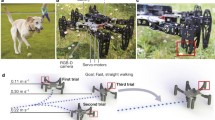Abstract
A model for integration of low-level responses to damage, potential damage and component failure in robots is presented. This model draws on the notion of inflammation and introduces an extensible, sub-symbolic mechanism for modulating high-level behaviour using the notion of artificial inflammation. Preliminary results obtained via simulation are presented and demonstrate the potential benefits of such a scheme. Additionally the system maps the robot’s physiological state-space, which is defined in terms of the levels and sources of inflammatory response. This is achieved using Kohonen’s Self-Organizing Map algorithm to arrange the states experienced during the lifetime of the robot. The future use of this map for diagnosis and localization of faults and for the generation of specific high-level remediation behaviour is also discussed.
Preview
Unable to display preview. Download preview PDF.
Similar content being viewed by others
References
Brooks, R.: A robust layered control system for a mobile robot. IEEE Journal of Robotics and Automation 2(1), 14–23 (1986)
Clancey, W.: Situated Cognition: On Human Knowledge and Computer Representations. Cambridge University Press, Cambridge (1997)
de Castro, L.N., Timmis, J.: Artificial Immune Systems: A New Computational Intelligence Approach. Springer, Heidelberg (2002)
Greensmith, J., Aickelin, U., Cayzer, S.: Introducing dendritic cells as a novel immune-inspired algorithm for anomaly detection. In: Jacob, C., Pilat, M.L., Bentley, P.J., Timmis, J.I. (eds.) ICARIS 2005. LNCS, vol. 3627, pp. 153–167. Springer, Heidelberg (2005)
Kohonen, T.: Self-organised formation of topologically correct feature maps. Biological Cybernetics 43, 59–69
Kohonen, T.: Self-organising Maps. Springer, Heidelberg (1995)
Neal, M., Timmis, J.: Timidity: A Useful Mechanism for Robot Control? Informatica 27(4), 197–204 (2003)
Neal, M., Timmis, J.: Once more unto the breach.. towards artificial homeostasis? In: Recent Advances in Biologically Inspired Computing, IGP (2004)
Sompayrac, L.: How the immune system works. Blackwell, Malden (2002)
Trapnell Jr., B.C.: A peer-to-peer blacklisting strategy inspired by leukocyte-endothelium interaction. In: Jacob, C., Pilat, M.L., Bentley, P.J., Timmis, J.I. (eds.) ICARIS 2005. LNCS, vol. 3627, pp. 339–352. Springer, Heidelberg (2005)
Author information
Authors and Affiliations
Editor information
Editors and Affiliations
Rights and permissions
Copyright information
© 2006 Springer-Verlag Berlin Heidelberg
About this paper
Cite this paper
Neal, M., Feyereisl, J., Rascunà, R., Wang, X. (2006). Don’t Touch Me, I’m Fine: Robot Autonomy Using an Artificial Innate Immune System. In: Bersini, H., Carneiro, J. (eds) Artificial Immune Systems. ICARIS 2006. Lecture Notes in Computer Science, vol 4163. Springer, Berlin, Heidelberg. https://doi.org/10.1007/11823940_27
Download citation
DOI: https://doi.org/10.1007/11823940_27
Publisher Name: Springer, Berlin, Heidelberg
Print ISBN: 978-3-540-37749-8
Online ISBN: 978-3-540-37751-1
eBook Packages: Computer ScienceComputer Science (R0)




